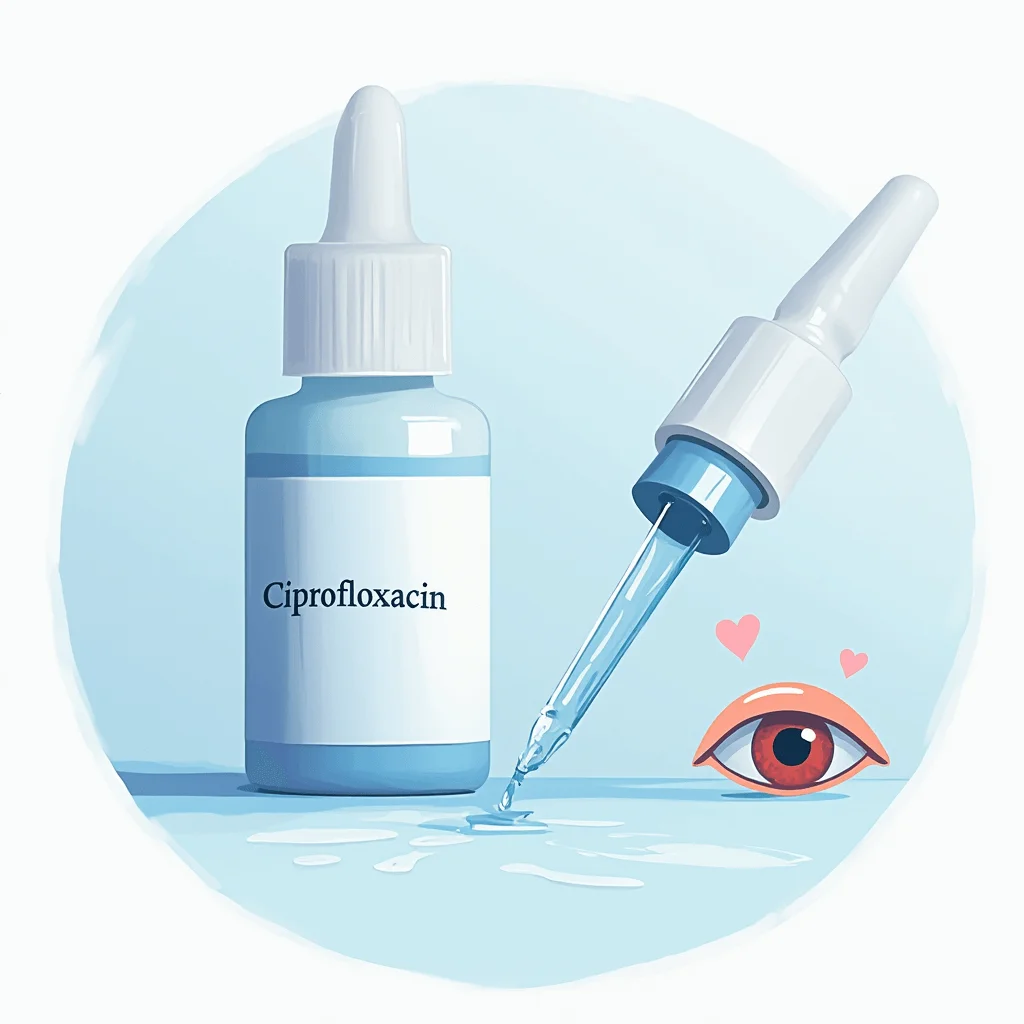Table of Contents
Are you struggling with an annoying eye infection? Ciprofloxacin eye drops can help. They are an eye solution that is great for treating bacterial eye infections. In this blog post, we will look at what Ciprofloxacin is, how it works, its benefits, and what side effects it might have. Let’s find out more about this treatment to help you make good choices for your eye health.
Key Highlights
- Ciprofloxacin eye drops are ophthalmic solutions used to treat bacterial infections of the eye, like conjunctivitis.
- They contain ciprofloxacin, a potent antibiotic that combats bacterial growth.
- These eye drops are available with a doctor’s prescription and come in both solution and ointment forms.
- Common side effects are generally mild and may include temporary stinging or burning upon application.
- It’s crucial to complete the full course of treatment as prescribed, even if symptoms improve.
Understanding Ciprofloxacin Eye Drops
Ciprofloxacin ophthalmic solution, also known as Ciprofloxacin eye drops, is a strong antibiotic used to treat bacterial infections in the eye. It is often used for bacterial conjunctivitis, which many people call pink eye.
Ciprofloxacin eye drops are part of a group called quinolone antibiotics. They work by stopping the growth of bacteria that lead to infections. By targeting these harmful germs, this medication helps relieve the discomfort caused by eye infections.

What Are Ciprofloxacin Eye Drops?
Ciprofloxacin eye drops are a type of antibiotic. They are made to treat bacterial infections in the eyes. This eye medicine works by killing the bacteria that cause the infection, which helps you feel better.
You can only get Ciprofloxacin eye drops with a prescription. They are often used for problems like bacterial conjunctivitis, which is also known as pink eye. It is important to use this medicine the way your doctor says to make sure it works well and keeps you safe.
It’s important to avoid treating eye infections by yourself. You should always talk to your doctor or eye doctor for the right diagnosis and treatment.
How Ciprofloxacin Eye Drops Work in Treating Eye Infections
Ciprofloxacin eye drops are a type of quinolone antibiotic. They fight eye infections by going straight for the bacteria causing the problem. These drops stop the bacteria from making more copies of themselves and from repairing their DNA. This leads to the bacteria’s death.
By targeting the bacteria, the drops stop the infection from spreading in the eye. This gives relief from discomfort and helps the eye heal.
What makes Ciprofloxacin eye drops strong is their ability to kill germs. That is why many people choose them to treat bacterial eye infections.
Comprehensive Guide to Using Ciprofloxacin Eye Drops
It is important to know the right way to use Ciprofloxacin eye drops. This understanding helps make the treatment work better. Let’s look at the steps you need to follow to use these drops safely and effectively for your eye infection.
We will talk about steps like washing your hands and putting in the drops. Following these instructions can help get the best results from the treatment.
Proper Application Techniques for Maximum Benefit
Administering eye drops correctly helps deliver the medicine to the affected eye and gives you the best results. Here is a simple step-by-step guide to use your Ciprofloxacin eye drops:
First, wash your hands well with soap and water. This stops germs from getting into your eye. Next, gently shake the bottle to mix the medication.
- Use a clean tissue to wipe away any discharge from your eye.
- Tilt your head back slightly. Pull down your lower eyelid with your index finger. This makes a small pocket.
- Hold the dropper close to your eye but do not touch the tip to your eye, eyelashes, or fingers.
- Squeeze the bottle gently to release a single drop into the pocket of your lower eyelid.
- Slowly close your eye for a few minutes. Press lightly on the inner corner of your eye. This helps keep the medicine from draining into your tear duct.
Dosage Recommendations and Duration of Treatment
The appropriate dosage and duration of Ciprofloxacin treatment hinge on the specific eye infection and its severity. Your doctor will provide personalized instructions that should be followed carefully. However, as a general guideline:
Dosage Forms and Administration:
| Dosage Form | Typical Dosage |
| Eye Drops | 1-2 drops in the affected eye(s) every 2-4 hours for the prescribed duration |
| Eye Ointment | ½-inch strip in the affected eye(s) 2-3 times daily for the prescribed duration |
Missed Dose:
In case of a missed dose, instill it as soon as you remember. However, if it’s almost time for your next scheduled dose, skip the missed dose and resume your regular dosing schedule. Avoid using extra drops to compensate for the missed dose. If you have concerns about missed doses, contact your doctor or pharmacist for guidance.
Side Effects and Safety Precautions
Ciprofloxacin eye drops are usually safe. However, they can cause side effects in some people. Most of these side effects are mild and often go away on their own. It is important to know about these possible reactions so you can handle them if needed.

Here are some common side effects of Ciprofloxacin eye drops. Also, we will highlight important precautions to keep in mind for safe and effective treatment.
Common Side Effects to Watch For
Like other medications, Ciprofloxacin eye drops can have side effects. Not everyone will have these issues. It is helpful to know about these side effects so you can get medical attention if you need it.
Common side effects of Ciprofloxacin eye drops are often mild and go away quickly. They can include:
- A burning or stinging feeling when you use the drops
- Temporary blurry vision
- A bitter taste in your mouth
- Discomfort or irritation in the eyes
Usually, these side effects go away as your eyes get used to the drops. If you have side effects that don’t go away or are very bothersome, talk to your doctor or pharmacist. They can help you understand what side effects are normal and which ones may need more attention.
Serious Side Effects and How to Respond
It’s rare, but you should know about serious allergic reactions to Ciprofloxacin eye drops. If you see any of these signs, stop using the drops right away and get medical help:
- Severe swelling in your face, eyelids, lips, tongue, or throat
- Trouble breathing or feeling like you can’t catch your breath
- Hives, itching, or a skin rash
- Fast or irregular heartbeat
- Dizziness or feeling faint
Getting prompt medical attention is very important for serious allergic reactions. It helps manage the reaction and can reduce complications. If you notice serious side effects, it’s better to be safe and contact your healthcare provider as soon as you can.
Interactions and Contraindications
Ciprofloxacin eye drops, like other medicines, can change how some medications work together. These interactions can cause more side effects or make the treatment less effective.
Also, having some medical conditions before taking Ciprofloxacin eye drops might not be safe. It is important to know about these interactions and health issues to keep you safe and ensure the medicine works well.
Medications That May Interact with Ciprofloxacin Eye Drops
While it’s rare, Ciprofloxacin eye drops can interact with other medications. It’s very important to tell your doctor about all the medications you take. This includes prescription drugs, over-the-counter medications, vitamins, dietary supplements, and herbal products.
When you share this information, your doctor can check for possible interactions. They may change your medications or their doses if necessary. Providing a full history of what you take helps your doctor make better choices and reduces the chance of negative reactions.
Always share with your doctor:
- Any allergies you have to medications, especially antibiotics.
- Past experience with Ciprofloxacin or other quinolone antibiotics.
Conditions That May Affect Safe Use of Ciprofloxacin Eye Drops
It is very important to tell your health care professional about any allergies you have, especially to antibiotics. Also, mention if you have ever had an allergic reaction to Ciprofloxacin or other similar medicines.
Some conditions may make using Ciprofloxacin eye drops risky. These are called contraindications. You may need a different treatment if you have:
- A known allergy to Ciprofloxacin or any of the ingredients in the eye drops.
- Certain types of corneal ulcers.
Giving your complete medical history to your doctor will help make sure that the treatment plan is safe and right for you.
Conclusion
Ciprofloxacin Eye Drops are a helpful option for treating different eye infections. It is important to know how to use them correctly, follow the right dosage, and be aware of side effects. You should look out for both common and serious side effects, and also check how they might interact with other medicines. Talk to your healthcare provider for advice on how to use Ciprofloxacin Eye Drops safely. If you have more questions about how to use them, possible alternatives, or if they work with contact lenses, you can check the FAQs or get help from a professional. Take care of your eye health and stick to the guidelines for the best results.
References
- Rick Davis and Anthony Markham and Julia Balfour, Ciprofloxacin. An updated review of its pharmacology, therapeutic efficacy and tolerability,Drugs, 51(6),1996,1019-74. DOI:10.2165/00003495-199651060-00010.
- Diamond JP, White L, Leeming JP, Bing Hoh H, Easty DL. Topical 0.3% ciprofloxacin, norfloxacin, and ofloxacin in treatment of bacterial keratitis: a new method for comparative evaluation of ocular drug penetration. Br J Ophthalmol. 1995 Jun;79(6):606-9. https://doi.org/10.1136/bjo.79.6.606.
- Hyndiuk RA, Eiferman RA, Caldwell DR, Rosenwasser GO, Santos CI, Katz HR, Badrinath SS, Reddy MK, Adenis JP, Klauss V. Comparison of ciprofloxacin ophthalmic solution 0.3% to fortified tobramycin-cefazolin in treating bacterial corneal ulcers. Ciprofloxacin Bacterial Keratitis Study Group. Ophthalmology. 1996 Nov;103(11):1854-62; discussion 1862-3. DOI: 10.1016/S0161-6420(96)30416-8.
- Leibowitz HM. Antibacterial effectiveness of ciprofloxacin 0.3% ophthalmic solution in the treatment of bacterial conjunctivitis. American Journal of Ophthalmology. 1991 Oct;112(4 Suppl):29S-33S. PMID: 1928271.
- Abbas Khan and Zafar Iqbal and Muhammad Imran Khan and Jamshaid Ali Khan and Muhammad Khalid and Zia Ahmad, Drug-drug interaction between ciprofloxacin and diclofenac ophthalmic drops at ocular level, African Journal of Pharmacy and Pharmacology, 5(2011).
Frequently Asked Questions
Can Ciprofloxacin Eye Drops Be Used for Children?
The Ciprofloxacin ophthalmic solution is mostly safe and works well for children and newborns. But, the Ciprofloxacin eye ointment is not safe for kids who are under two years old. It is best to talk to a healthcare professional for advice on how to use it and the right dosage for children.
How Long Does It Take for Ciprofloxacin Eye Drops to Work?
You should see your eye infection symptoms get better in a few days after you start using Ciprofloxacin eye drops. It is very important to finish the full treatment as your healthcare provider advises. This will help effectively treat problems like bacterial conjunctivitis or corneal ulcers.
Are There Any Over-the-Counter Alternatives to Ciprofloxacin Eye Drops?
Ciprofloxacin eye drops are a prescription medication. This means you cannot find any direct over-the-counter (OTC) alternatives. If you have an eye infection, it is important to see a healthcare professional. They can give you the right diagnosis and treatment. This treatment may include prescription eye drops like Ciprofloxacin.
Can I Wear Contacts While Using Ciprofloxacin Eye Drops?
It is best to not wear contact lenses when you are treating an eye infection with Ciprofloxacin ophthalmic solution (Ciloxan) or other antibiotic eye drops. Contact lenses can hold bacteria and may make the infection worse or last longer.
Disclaimer: The information provided in this article is for educational and informational purposes only. It should not replace the advice, diagnosis, or treatment of a qualified healthcare professional. Always consult a licensed doctor or pharmacist before administering any antibiotics or treatments.
